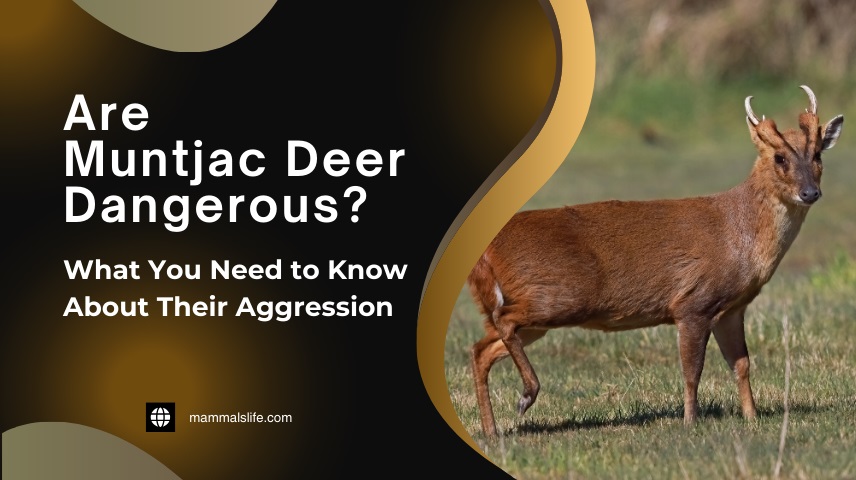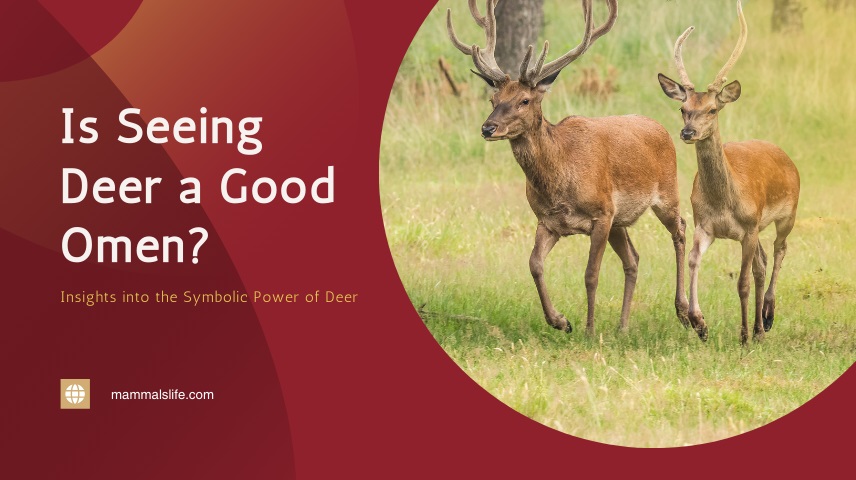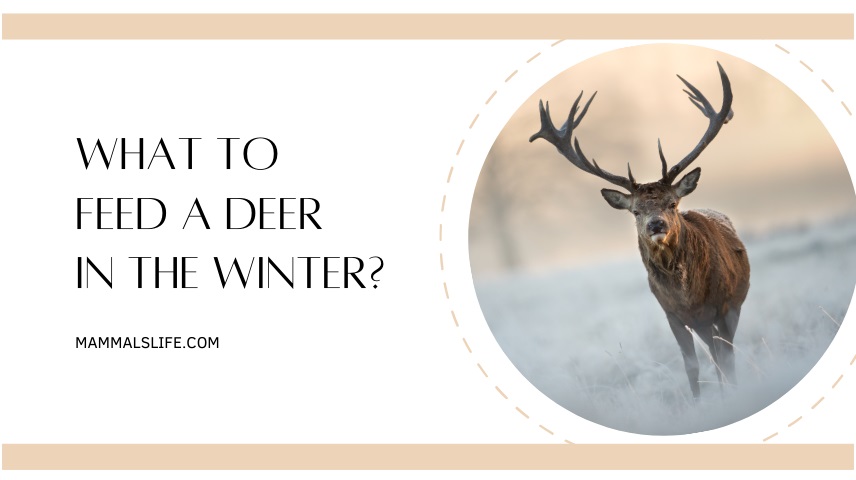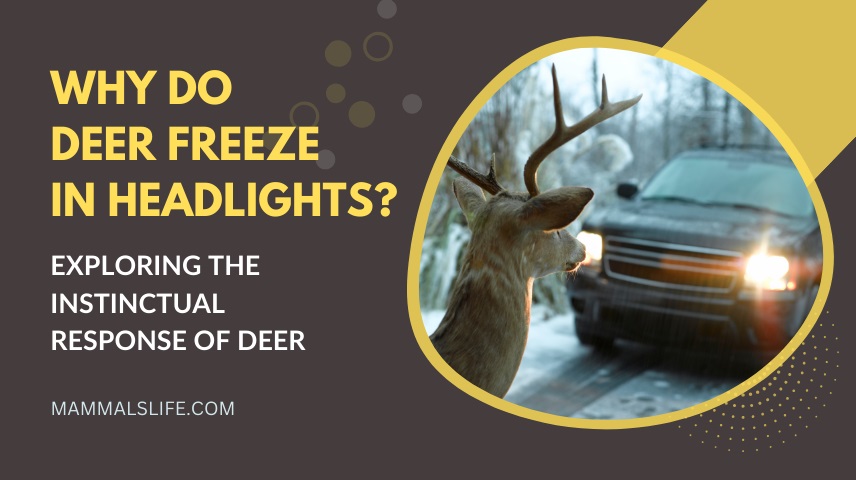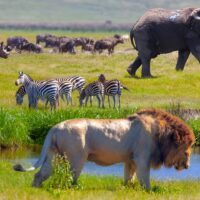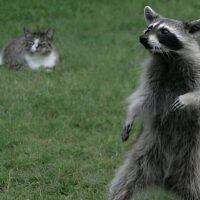Last Updated on February 22, 2025 by Mammals Life
Muntjac deer are generally not dangerous to humans. They can, however, exhibit aggression if they feel threatened.
Muntjac deer, also known as barking deer, are small and elusive creatures found mainly in Asia. These deer are known for their distinctive calls and sharp tusks. While they are not typically a threat to humans, they can become aggressive if cornered or provoked.
Understanding their behavior is crucial for safely coexisting with them. Muntjac deer use their tusks primarily for defense and during mating disputes. Recognizing signs of stress in these animals can help prevent unwanted encounters. Respecting their space and observing from a distance ensures a peaceful coexistence.
Introduction To Muntjac Deer
Muntjac deer, also known as barking deer, are small and intriguing animals. They are unique because of their distinctive bark-like call. These deer are often the subject of curiosity due to their appearance and behavior. Understanding them can help clarify if they pose any danger.
Species Overview
Muntjac deer belong to the genus Muntiacus. They are known for their small size and unique physical features. Males have small antlers and tusk-like canine teeth. These teeth can be a reason for their perceived aggression.
Habitat And Distribution
Muntjac deer originally come from Asia. They thrive in tropical and subtropical regions. Today, they also live in parts of Europe and the UK. These deer prefer dense forests, but they can adapt to various environments.
| Region | Common Habitat |
|---|---|
| Asia | Dense forests, grasslands |
| Europe | Woodlands, urban areas |
| UK | Gardens, parks |
Read More – Why Do Deer Stomp Their Feet? A Closer Look at Deer Warning Signals
Behavioral Traits
Muntjac deer, often called “barking deer,” have unique behaviors. Understanding their habits can help you stay safe around them.
Daily Activities
Muntjac deer are mostly active during dawn and dusk. They spend their time foraging for food like leaves, fruits, and twigs. They prefer dense forest areas where they can hide easily. During the day, they rest in thick bushes to avoid predators.
| Time of Day | Activity |
|---|---|
| Dawn | Foraging |
| Daytime | Resting |
| Dusk | Foraging |
Social Structure
Muntjac deer are mostly solitary animals. They prefer to live alone except during mating season. Male muntjacs are territorial and mark their area with scent glands. They defend their territory aggressively against other males. Female muntjacs live alone with their young ones.
- Solitary Nature: Muntjacs prefer to live alone.
- Territorial Males: Males mark and defend their territory.
- Protective Mothers: Females live alone with their fawns.
Read More – How Rare Are Piebald Deer? Exploring the Genetics And Occurrence of Piebaldism
Aggression In Muntjac Deer
Muntjac deer are small and shy. But, they can be aggressive. Understanding their behavior is important. You will learn about their aggression, signs, and triggers.
Signs Of Aggression
Look for these signs in muntjac deer:
- Stomping their feet
- Lowering their head
- Showing their teeth
- Making loud noises
- Charging towards you
Triggers For Aggressive Behavior
| Trigger | Description |
|---|---|
| Territorial Defense | Muntjac deer protect their area. They may attack intruders. |
| Food Competition | They fight for food. They become aggressive when hungry. |
| Mating Season | During mating season, males fight for females. |
| Feeling Threatened | When scared, they may attack to protect themselves. |
Muntjac deer can be dangerous. Watch for signs and triggers of aggression. Stay safe and keep your distance.
Human Interactions
Human interactions with muntjac deer can be both fascinating and risky. These small deer are known for their secretive nature. They tend to avoid humans but may show aggression if cornered or threatened. Understanding their behavior helps ensure safe encounters.
Encounters In The Wild
Spotting a muntjac deer in the wild is rare. They prefer dense forests and thick undergrowth. These deer are active during dawn and dusk, making them harder to see. If you do see one, keep your distance. Muntjac deer have sharp tusks which they use for defense. They might feel threatened and react aggressively.
Safety Precautions
Follow these safety tips to avoid dangerous encounters:
- Keep your distance: Do not approach or try to feed the deer.
- Stay quiet: Loud noises can startle them and provoke an attack.
- Watch your pets: Dogs can provoke a defensive response from the deer.
- Avoid dense areas: Stick to open paths where you can see clearly.
- Stand your ground and make yourself look bigger.
- Use a firm voice to scare it away.
- Back away slowly without turning your back on the deer.
Following these steps can help keep both you and the deer safe.
Read More – What Is a Piebald Deer? A Comprehensive Guide to These Rare And Beautiful Deer
Impact On Environment
Muntjac deer, with their growing numbers, significantly impact the environment. Their presence disrupts ecosystem balance and damages vegetation and crops.
Ecosystem Balance
Muntjac deer threaten the natural balance of ecosystems. They eat young tree saplings, which affects forest regeneration. This can lead to less diverse plant species. With fewer trees, animal habitats shrink, affecting other wildlife.
Vegetation And Crop Damage
Muntjac deer cause severe vegetation and crop damage. They feed on a variety of plants, including garden plants and crops. Farmers suffer losses due to their feeding habits. Gardens become barren as deer munch on flowers and shrubs.
| Type of Damage | Details |
|---|---|
| Tree Damage | Deer eat young saplings, hindering forest growth. |
| Crop Damage | Deer feeds on garden plants, making gardens barren. |
| Garden Damage | Deer feed on garden plants, making gardens barren. |
To summarize, the impact of Muntjac deer on the environment is significant. They disrupt ecosystems and cause damage to vegetation and crops, leading to ecological and economic challenges.
Conservation And Management
Muntjac deer are small but can be aggressive. Managing their population and conservation is essential. This helps keep balance in their habitat.
Population Control
Managing the muntjac deer population is crucial. Too many can harm the environment. They can destroy plants and trees. This affects other animals and plants.
There are different ways to control their numbers:
- Hunting
- Trapping
- Relocation
Local authorities may also use birth control. This helps to reduce their numbers without harm.
Legal Regulations
Legal regulations help manage muntjac deer. These laws protect the environment and people. Many countries have specific rules for hunting and trapping. It is important to follow these rules.
Here is a table of some legal regulations in different countries:
| Country | Regulations |
|---|---|
| United Kingdom | License required for hunting |
| United States | Varies by state |
| Australia | Permit required for trapping |
Always check local laws before taking action. This ensures you follow the proper procedures.
Frequently Asked Questions
Are Muntjac Deer Dangerous?
Muntjac deer are generally not dangerous. They can become aggressive if cornered or threatened, especially during mating season.
What Is The Predator Of The Muntjac Deer?
The main predator of the muntjac deer is the leopard. Leopards are known to hunt and prey on muntjac deer in the wild.
How Do Muntjac Attack?
Muntjac attack by using their sharp antlers to defend against threats or during mating season. They may also kick or bite when provoked.
Why Do Muntjac Deer Scream?
Muntjac deer scream to communicate distress, signal danger, or establish territory. These vocalizations help them avoid predators.
Are Muntjac Deer Aggressive?
Muntjac deer can show aggression, especially during mating season. They may bite or kick when threatened.
Conclusion
Understanding Muntjac deer aggression is crucial for safety. They can be aggressive, especially during mating season. Always keep a safe distance. Educate others about their behavior to avoid conflicts. With awareness and caution, you can coexist peacefully with these fascinating creatures.
Stay informed and protect both yourself and the deer.

